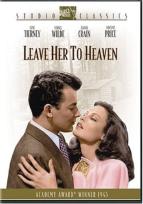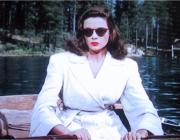Leave Her To Heaven (1945) 110 m. dir. dir. John M. Stahl writ. Jo Swerling [from novel by Ben Ames Williams] cine. Leon Shanroy [effects by Fred Sersen] [Technicolor by Natalie Kalmus & Richard Mueller] art. Lyle Wheeler & Maurice Ransford edt. James B. Clark music. Alfred Newman sound. E. Clayton Ward & Roger H. prod. William A. Bacher
star. Cornel Wilde (Richard Harland) Gene Tierney (Ellen) Jeanne Crain (Ruth) Vincent Price (Robie) Daryl Hickman (Danny) May Philips Ray Collins Gene Lockhart Chill Wills
Twentieth Century Fox 1945 | Technicolor 110 mins
 |||
Two men stand on a landing beside the placid water watching a launch approach:
here comes Richard Harland [Cornel Wilde], novelist, just sprung from two years
in jail for withholding information concerning the death of his wife. Although
they are supposed to be in rural Maine, everyone is wearing a fresh suit, like
store window dummies on display in a big city. Even Harland, who, after an
exchange of subdued pleasantries, skilfully slips into a canoe without scuffing
his shoes or losing his hat, starts paddling for his writer's retreat, a funky
log house known as "Back of the Moon" where Ruth [Jeanne Crain], the sister of
his dead wife, awaits on the dock, dressed as if she's just stepped out of an
ad for sensible clothing in the Ladies Home Journal.
|||
Two men stand on a landing beside the placid water watching a launch approach:
here comes Richard Harland [Cornel Wilde], novelist, just sprung from two years
in jail for withholding information concerning the death of his wife. Although
they are supposed to be in rural Maine, everyone is wearing a fresh suit, like
store window dummies on display in a big city. Even Harland, who, after an
exchange of subdued pleasantries, skilfully slips into a canoe without scuffing
his shoes or losing his hat, starts paddling for his writer's retreat, a funky
log house known as "Back of the Moon" where Ruth [Jeanne Crain], the sister of
his dead wife, awaits on the dock, dressed as if she's just stepped out of an
ad for sensible clothing in the Ladies Home Journal.
Even Nature itself seems groomed and artificial, like an illuminated model in a museum, an idealized form of quarantined beauty that exists only for contemplation. Even though much of this film was shot on location, the use of deep focus Technicolor renders the landscape as Elysian as a Maxfield Parrish painting. The actors, the sets, the lighting, are all locked into a strict art design, so that the color code of green and blue declensions suggests magazine ad art, people modelled to defeat death by virtue of being clean and sensible... just like a 1940's National Geographic layout. Too weird? For some, yes... but for others this is part of the directorial style that harnesses the stiff emotions of the characters and the technology of Technicolor to create a fascinating study of human psychosis.
Richard and Ruth embrace, reunited after the nightmare... and the rest of the film is a flashback, told in sequential Time.
Act 1
Cut To: the lounge car of a train moving through the desert landscape of New Mexico. The beautiful Ellen Berent [Gene Tierney] is reading a novel called Time Without End. Sitting opposite (by chance) is the author, Richard Harland. This fated meeting -- which has probably happened to every author at least once -- is just the stuff of fiction. Quite possibly his novel starts with this exact romantic encounter, although we never find out. Yet there seems to be some sort of spiritualist vibe within coincidence, because Ellen stares at Harland as if she's rediscovered someone she already knows.
Love at first sight, some will say... but when we learn that she's en route to Rancho Jacinto to scatter her father's ashes, another level of obsession is introduced. And while some will say Tierney and Wilde are barely competent as actors and sleep-walk their way through their parts, the restrained quality of their emotions fits the bourgeois culture of mid-century consumer America. The values are from the previous century, befitting an itinerant Jamesian society of female comfort and modulated beauty.
Who is Ellen? A sex-bomb in a rayon suit, a daddy's girl who is already engaged to a young District Attorney called Robie (Vincent Price), a man who is more concerned about the damage to his political persona than to his mental health by her desertion. As a femme fatale, her objective isn't money and dangerous sex, but rather possession, complete and utter. Her father was a scientist, a man with a lab in the attic. His ashes are now in a silver chalice. Ellen rides through the incredible New Mexican sierra, chalice aloft like an Olympic torch, releasing the ashes into his favorite view spot, while her new lover stalks her in the distance, a Freudian protege painted into the landscape.
The craziness of it all is reminiscent of Capra's Lost Horizon, where the characters ride and frolic in the splendid wilderness of Shangri La divorced from pain and death. Despite the well-stacked gun-rack that shows up in several scenes at Rancho Jacinto, this is an American paradise... and in fact the only dangerous animal around is Gene Tierney. She buries her father, dumps her fiance, marries her lover -- all in a matter of days. While her mother seems concerned, she likes her new son-in-law, says nothing, even though we realize she knows something he should know.
The exact history and politics of the family remain obscure, so we know nothing of Ellen's mother, who apparently preceded the current Mrs. Berent. Ruth [Jeanne Crain], her adopted sister (a cousin), is another model of restraint and concealed emotion, who puts duty first and personal gratification second. She's a stock character in such dime novel romances, the good sister who plays second fiddle to the older, more glamorous sibling. Here she sits at the piano, although she could be knitting.
Electra
Married, the happy couple leave Jacinto and visit another paradise, Warm Springs, Georgia, where Harland's younger brother Danny is receiving therapy for polio. Truly a dependant, Danny represents the first blight on the happy couple's marriage, although his condition is romantic, without disfigurement and contagion, so that we don't immediately understand why Ellen doesn't want him around. Her character as a selfish bitch is now established, even though she does an about face, and Danny accompanies the couple to the Maine paradise on Deer Lake, "Back of the Moon". Her selfish, possessive nature is reinforced when she discovers Harland has invited her mother and sister to visit. The script or perhaps the editing has left out important information here, as Ellen's neurotic behaviour is clearly at odds with her breeding and the facts as presented. For example, if Mrs. B. is actually her step-mother, then we might allow some justification for her erratic spoiled-brat actions. Stahl's direction is to cast her as evil and manipulative, rather than as an insecure child-woman with an Electra complex who should be cut a bit of slack. No doubt her "daughter of Satan" persona comes from the Biblical rhetoric of the southern writer Ben Ames Williams, who wrote the novel, but as the script goes, little room is left for us to sympathize with her situation.

|| The famous scene from this film shows the drowning of Danny as the beautiful Ellen sits in the rowboat nearby, does nothing. According to Daryl Hickman, who played the part of Danny, the studio boss Darryl F. Zanuck was so impressed that when he viewed the rushes, he proclaimed this scene to be the greatest in all film to that date. For 1945, it certainly pushed a moral button. Homicide by negligence, or malign opportunity? As Danny struggles in the cold waters of the lake, cries for help, Ellen sits motionless in the boat like a Vogue Magazine sphinx, eyeless behind her sunglasses, a prisoner of the trance that binds her in its Oedipal shroud. Is the crippled Danny a proxy for Ruth, the sister she suspects is in love with her husband? Or is she simply too vain to get her clothes wet, her make-up mussed.
I'll never let you go - never
Act 4 sees the "action" move to the Berent family home at Bar Harbor on the coast of Maine. It's in this Ladies Home Journal setting that Harland finishes his Mexican novel, The Deep Well. When Ellen discovers that he's dedicated it to the gentle gardener Ruth with the inscription "to the gal with the hoe", she decides that they are having a secret affair, plan a rendezvous in Mexico. She engineers a fall down the stairs, has a miscarriage, then poisons herself, making her suicide appear to be murder by the hand of her sister, knowing that her discarded fiance Robie will indict Ruth for murder.
Evil? That's what everyone calls this piece of twisted Hollywood algebra. The young Vincent Price, who plays Robie, prosecutes the case in a final courtroom Act with that faux gothic malevolence that was to become his signature style. The fact that as a prosecutor he's in a conflict-of-interest, and that an absurd confession of love while on the stand by Ruth make the denouement both contrived and propagandistic drifts past in the sweet studio light. When Harland declares his deceased wife to be "a monster", it's out of character because he seems incapable of anger, and for a writer, incredibly naive. Miscasting? Possibly. Perhaps we don't care because the photographic splendor of the courtroom distracts us with its artificial complexion and symbolic tones. Once again the color green... green walls, green dresses, green trains. It's a powerful visual motif, one which integrates the action even when the action appears to be illogical or missing scenes.
Leave Her To Heaven can be called a costume drama, because the artistic direction makes it so. Like a group of peasants called in to be extras, the cast is always in its Sunday best, in contradiction with everyday reality. Whether he's at his typewriter in the blazing poolside heat of New Mexico or on the veranda of his cabin in Maine, Richard Harland is dressed formally. Outside the movies, Gene Tierney was a model, so of course she looks great in the endless series of avant fashion gear, and again we don't care if she always looks as if she's on a runway. The visual idealization of the Technicolor cinematography overpowers us with its erotic symmetry, that consumer pornography that Hollywood so often aspires to... as if the producer is selling sections of the screen to various products. The beautiful settings demand statues, not people... hence the action appears neo-classical, with a certain mythological imagery re-played within a modern American context.
Great as a mural, weak as a drama. A woman resents a man's time alone, which, because he is a writer, is dream. He writes his, she acts hers.
© LR 7/05